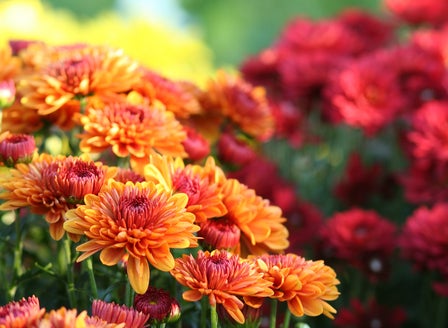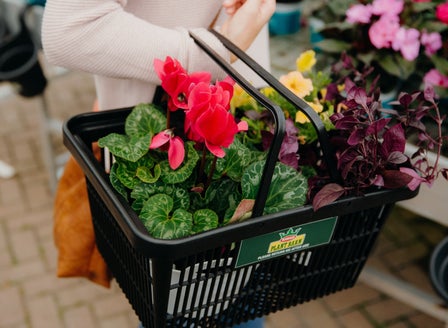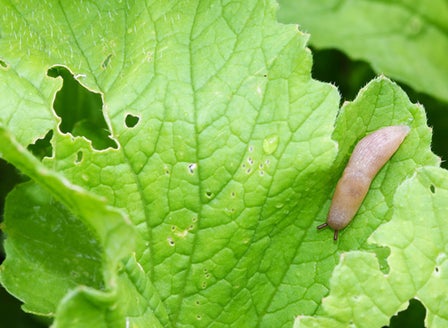Cyclamen are great for adding some winter colour either to your garden, outside pots or inside your home. Often flowering for many months from April onward and available in pink, red and white. Some Cyclamen are also scented.
Planting Calendar
Cyclamens are best planted from March until September.
Prepare
Position
From late autumn to early spring, provide plants with morning sun, and bright indirect light for the remainder of the day. They grow very well planted under deciduous trees where they receive shade in the summer and extra light in the winter when the trees are without their leaves. If planted in pots, they can simply be moved to the shade in the warmer months. They can also be grown inside too, in a well lit position but out of direct light. They prefer a cool room where there is not a lot of artificial heating.
Soil
When planted into the ground, Cyclamen like a free draining soil that is rich in organic matter. To improve the organic content in your soil, break up the soil and add Kings Compost and Kings Sheep Pellets then mix together well. When growing in containers indoors or out, plant into Kings Potting Mix.
Plant
When planting into the ground, gently tap the plant out of its pot. Dig a hole twice the depth and width of the plants root ball. Mix Kings Compost into your existing soil at a 50/50 ratio, add Sheep Pellets then mix together. Back fill the hole with this soil, so that when planted the top half of the tuber should be just above the soil for adequate drainage and to avoid tuber rot. Firm the soil down gently and water in well with Aquaticus Organic Garden Booster. In heavier clay soils, where drainage is likely to be an issue, plant onto a raised mound and sprinkle Gypsum Clay Breaker into the bottom of the hole, this helps slowly condition the soil and help to break down the clay. When planting into containers indoors or out, plant into Kings Potting mix.
Care
Watering
Incorrect watering (especially over watering) can cause problems. Always wait until the soil surface feels slightly dry before watering, but don’t wait until the plant becomes limp. Do not water the centre of the plant or the tuber may rot. If growing inside, allow the plant to drain over a sink and make sure it does not sit in water in a cover pot or saucer.
Feeding
Feed your cyclamen with a liquid fertiliser such as Kings Fast Food, mixed at half the usual strength. Apply every 3 to 4 weeks, starting about a month after you receive the plant. Over-feeding is more likely to produce foliage than flowers.
Protecting
Protect new growth form slugs and snail by applying Tui Quash as soon as growth emerges. When using sprays, chemicals or fertilisers always read the label and follow the instructions. Apply sprays in the evening to avoid harming beneficial insects.
Mulching
Mulching is not needed with cyclamen as it may cause the tuber to rot.
Spraying
Aphids and mites can at times be a problem, more often on Indoor grown cyclamen. Spray at first sign of insects with Groventive Garden or for a organic option spray with Bugtrol.
Pruning
Removal of yellow leaves or old flowers is all that is required.
General Care
AFTER FLOWERING CARE When the plant stops flowering (late spring), the leaves will begin to turn yellow, and the plant will become dormant. Most people discard the plant at this point, however, if given correct care it will flower again the following season. If in a pot, keep it in a cool, dry place, allowing the corm to dry out. Repot early autumn. Use a quality free-draining potting mix, such as Kings Potting Mix. Watering too early can trigger new growth prematurely. When new foliage begins to grow again, water the soil thoroughly and continue to keep moist
Beginner Tip
It is important to allow cyclamen to dry out for two to three months and go dormant. Water a little through this period but not too much as you may rot the corm.
Expert Tip
Over watering or allowing the plant to sit in water can cause Botrytis, which appears as black grey fungus on the stems and flowers. In addition the leaves may go yellow and have brown patches. Remove infected parts of the plants and reduce watering.
Tip
Removing old flowers (dead-heading) will encourage new flowers to form. Gently remove flowers by giving a quick light tug to remove the whole stem.
Frequently Asked Questions
What should I do after the plant has finished flowering?
When the plant stops flowering (late spring), the leaves will begin to turn yellow, and the plant will become dormant. Most people discard the plant at this point, however, if given correct care it will flower again the following season. If in a pot, keep it in a cool, dry place, allowing the corm to dry out. Repot early autumn. Use a quality free-draining potting mix, such as Kings Potting Mix. The top half of the tuber should be just above the soil for adequate drainage and to avoid tuber rot. Watering too early can trigger new growth prematurely. When new foliage begins to grow again, water the soil thoroughly and continue to keep moist.
Are cyclamen poisonous?
Like many flowers in the garden, cyclamen are poisonous if ingested by cats, dogs and humans. Just keep them out of reach from baby animals and toddlers.
How often should I water my Cyclamen?
Incorrect watering (especially over watering) can cause problems. Always wait until the soil surface feels slightly dry before watering, but don’t wait until the plant becomes limp. Do not water the centre of the plant or the tuber may rot. If growing inside, allow the plant to drain over a sink and make sure it does not sit in water in a cover pot or saucer.
When does Cyclamen bloom?
Cyclamen typically bloom from autumn to spring, providing vibrant colour during the cooler months. You can expect flowers from April to October.
What type of soil is best for Cyclamen?
When planted into the ground, Cyclamen like a free draining soil that is rich in organic matter. To improve the organic content in your soil, break up the soil and add Kings Compost and Kings Sheep Pellets then mix together well. When growing in containers indoors or out, plant into Kings Potting Mix.


